#marie kondo
Text
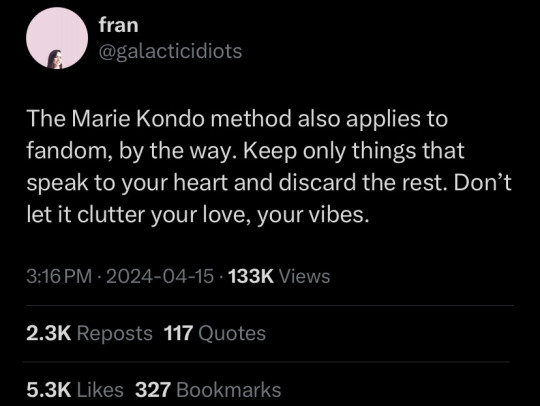
605 notes
·
View notes
Text
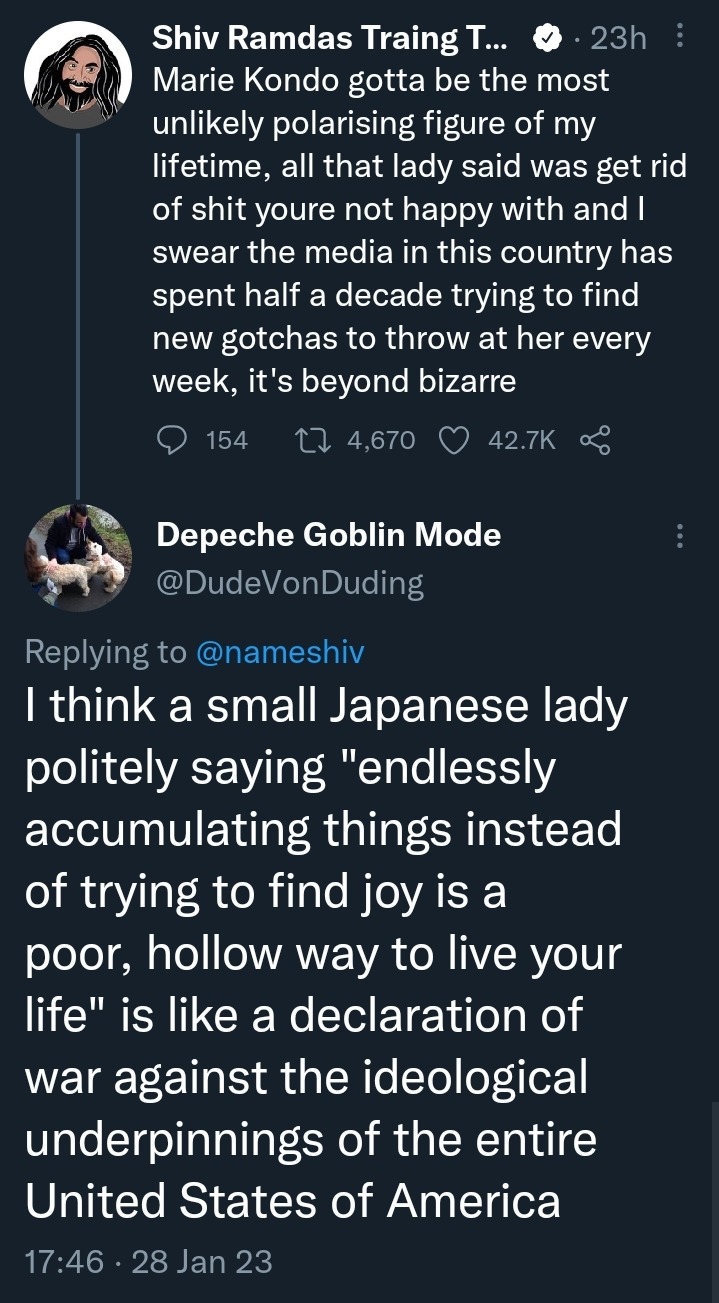
#marie kondo#konmari#racism#capitalism#consumer culture#consumerism#usamericans#white people#knee of huss
42K notes
·
View notes
Text
I was trapped in a maze of stacked furniture. Marie Kondo came to sing a song with me called “What Sparks Joy?” until I found my way out.
567 notes
·
View notes
Text
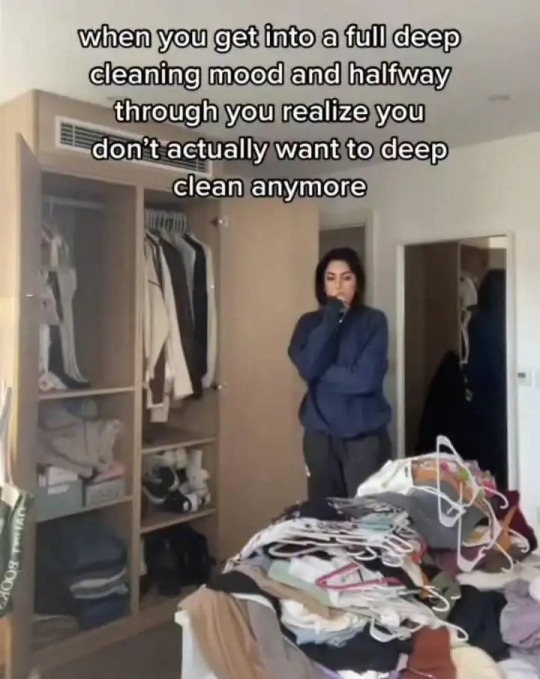
439 notes
·
View notes
Text
Why the Konmari method is pretty useless for people with genuine problems with hoarding and OCD, or OCD tendencies, at least without some caveats and definitions:
Hoarding is defined by a persistent emotional attachment to inanimate objects. Clutterers and hoarders often have an unconscious need to save items, whether for an imagined future ideal use, or just because otherwise they would end up in the landfill.
People with these issues often have difficulty discerning the difference between a truly useful item and something that should be given or thrown away because of their emotional attachment to the item.
They see themselves as the best curator of the items, which may range from useful items like craft supplies, display items, sentimental items, and stuff that is truly just junk.
"Sunk costs" is a term from economics that means that a cost that has already been incurred and cannot be recovered. Although the original term refers to finances, the sunk costs of the time and effort someone has put into an item can influence their decision to keep the item.
Therefore, another factor in this attachment is the sunk costs of money, effort, and time that a person has put into an item. A person may no longer be personally attached to an item, but will keep it because they have always meant to use it or simply because it's not yet ruined.
This is also a reason those with fewer economic advantage tend to be hoarders more than those with a comfortable financial situation. Someone like this realizing they've obtained two of an item will take on the responsibility of curating both instead of getting rid of one.
Because of all these factors, the expression that was translated as "sparks joy" in the English version is too easy for a clutterer to confuse or redefine in their own mind as they work to sort through their items.
In my case, for example, I had a situation where the basement, which was full of our excess saved items, needed to be cleared so the cracked foundation could be repaired. I had to decide what to save in the limited storage space we still had, and what to throw out or donate.
If Konmari had been in vogue at the time (this was in 2004) I'm certain I would have kept far more items than I should have. This language is too easy for a clutterer to massage and redefine in their own mind based on what the item is.
First, clutterers need to be clear-eyed about the fact that they suffer from excess emotional attachment to objects. Flylady's declutter method was in vogue at the time I engaged in this declutter session, and she has a whole checklist of questions to ask oneself about an object:
Do I love this item?
Have I used it in the past year?
Is it really garbage?
Do I have another one that is better?
Should I really keep two?
Does it have sentimental value that causes me to love it?
Or does it give me guilt and make me sad when I see the item?
This may seem needlessly complex to someone who is not a hoarder or clutterer but this addresses many of the reasons that a sufferer would keep an item that they shouldn't.
Another factor is that they are perfectionists. This seems at odds with the idea that they may have a huge mess in their home, but what happens is they often can't deal with their persistent need to have a perfectly clean home that matches their vision.
Because of this they put off starting on the project until it can be done perfectly.
This is why methods like Flylady and Unfuck Your Habitat (which is really just Flylady without the cutesy rhetoric) help these people so much, because people with differences such as ADHD become clutterers because they don't know how to regulate their own time or how to organize.
The emotional attachment to their possessions is, incidentally, why decluttering on behalf of your hoarder friend is a very bad idea. The person will need to work through this process on their own, in order for it to stick.
Getting rid of these items can be intensely emotional and difficult for someone with these tendencies.
Time limits, routines, consistency, and persistence are the best tools for someone who needs to declutter. Don't try to do this all in an afternoon. Not only is it a difficult process, it should become a consistent habit.
For resources and further reading please check out Squalor Survivors (archive.org link).
#mine#please feel free to ask me questions about this i am an old hand#squalor survivors#hoarding#ocd#obsessive compulsive disorder#ocd tendencies#konmari#konmari method#marie kondo#reposting everything from my twitter feed#i'm about to delete everything so get it while it's hot#tweet: 2019
293 notes
·
View notes
Text
🎥 tumanualidades.de
#diy#tutorial#do it yourself#tutorials#crafts#diy ideas#diy projects#easy diy#diy decor ideas#video tutorial#home improvement#craft#decoration#decor diy#decor#home decor#diy decor#diy videos#folding#marie kondo
855 notes
·
View notes
Text
i've said it before but i'll say it again:
as an adhder, the hard part about the konmari method is not the "don't keep things that don't spark joy" bit, it's the "put things away when you're done with them" bit.
113 notes
·
View notes
Text
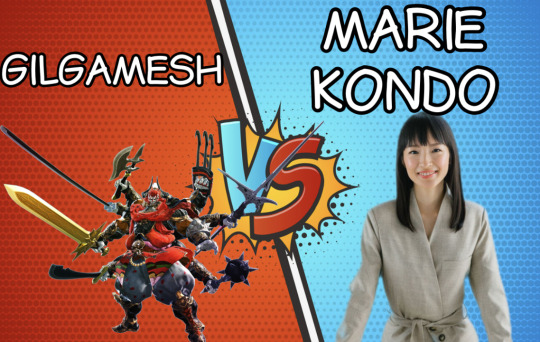
190 notes
·
View notes
Text
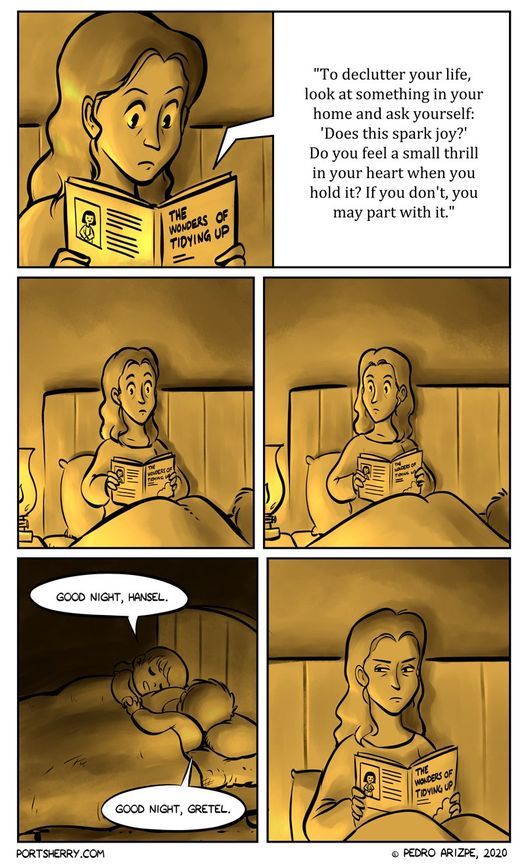
Not Mine. Thought to Share.
126 notes
·
View notes
Text

#meme#Marie Kondo#sparks joy#parks joy meme#Pinocchio#Guillermo del Toro#Disney#Netflix#live action remake#guillermo del toro's pinocchio
746 notes
·
View notes
Text
Ugh someone in the free stuff group wants a copy of Marie Kondo's book and naturally the most popular comment is about how she "gave up cleaning" and is a fraud #EmbraceTheMess
She had a third baby, fuckos. Her priorities changed now that she has to keep up with three young children, that doesn't mean she lied it means sometimes life gets in the way. #EmbraceTheMess all you like it that makes you happy, but why are you threatened by this petite Japanese woman who advises you just keep the things you're happy with and say goodbye to the things you don't? And I say that as a pathological hoarder.
361 notes
·
View notes
Text

the takeaway from the most recent episode
70 notes
·
View notes
Text
konmari tip
When I read that you should organize by taking everything off the shelves (books in particular) I scoffed and said there’s no way I’m doing that. However, I did decide that if I’m trying this philosophy out, I’m going to do it properly. At this point I was still very sceptical about konmari and was dead set on proving it WRONG.
So I did an experiment. I looked at my book shelf and found four books I wanted to get rid of, two of which have been in the back of my mind already.
Then, to follow through and do the decluttering properly, I took everything off the shelf and held each individual book in my hand. The ones I wanted to keep, I put on the shelf. The ones that held sentimental value I set aside.
And this is the important part: While there were no more than those four original books I acitvely wanted to get rid off, there was a whole pile of books that I didn’t necessarily want out of my sight, but which also sparked no joy whatsover.
I was completely indifferent towards these books. In fact, if I accidentally spilled coffee on them and ruined them, I wouldn’t as much as be upset about losing a good cup of coffee. I wouldn’t give a shit about having to throw the drenched books away.
And that made me realize that there was no point in me keeping these books anymore. And moreover, like Marie Kondo herself says in her book, it’s not fair on the items either. To exist in a home where they are not cared for. Where everyone only feels indifference towards them. What use are they serving? None.
And that may just be me displaying too much empathy towards inanimate objects, but it also lead me to another realization. Wouldn’t it be much better to donate these books so they could go to a new home to an owner who actually wanted them? To a home where someone read them and appreciated the stories in them? I didn’t need these books. I didn’t read them, I would never read them again.
Marie Kondo says that every item you possess has a function. And sometimes that function is to show you you don’t need that item after all, and that’s perfectly okay. Some of these books were like that - trifted or bought from sale because it gave me a momentary dopamine spike. And then some time passed and I realized I don’t need them after all. And that made me philosophisize more - perhaps the purpose of me owning that item for a while was to lead it in its intended place. Perhaps I found the item because when I did, it was already fate that I would realize I don’t need it and would put it forward and then the person it belongs to finds it.
idk. So philosophical haha, this was intended as a quick tip and then I spiraled lmao
332 notes
·
View notes
Quote
Discarding is not the point; what matters is keeping those things that bring you joy. If you discard everything until you have nothing left but an empty house, I don’t think you’ll be happy living there. Our goal in tidying should be to create a living environment filled with the things we love.
#Marie Kondo (Spark Joy)
75 notes
·
View notes
Text
So that post with me griping about how awful people are to Marie Kondo is something I dashed off in a sudden rage off the top of my head with absolutely zero idea that it would extend beyond a few people, and now that it's kinda blown up I'd just like to say a few things:
1. I am a person of color who experiences misogyny, but yeah I'm not immune to "for a moment I was so caught up in the euphoria of (cool person existing) that I lived in a world where (racism and sexism) didn't exist"
2. Shut up about the 30 books shut up about the 30 books SHUT UP ABOUT THE 30 BOOKS. Marie said that once she personally was done tidying her space, 30 books was the number that SHE ended up with and a number that SHE likes FOR HERSELF, and if it sparks joy for you to keep way more than that or none at all, then you should do it. Nowhere did she EVER say that you should throw away all but 30 of your books.
3. For those wondering where to learn about her method/read more, her book is called The Life Changing Magic of Tidying Up and it's worth every cent.
4. For those wanting a very very basic summary of her method, this is how it works: you tidy by category, not location. Order of category is important because it gets you used to the method and gives you practice on it going from what is typically easiest-hardest to let go of. The categories, in order, are clothes, books, papers, miscellaneous, and sentimental items. You go through each category one item at a time, hold the item in your hands for a second, and ask yourself if it's something that makes you happy to own it. If yes, or if it's a necessity you can't afford to replace or an important document/work thing, you keep it. If no, thank it for serving you, even if the thank you is just "thank you for teaching me I don't like wearing green", and toss it or donate it. That's it! There's more, but those are the basics.
397 notes
·
View notes
Text
furthermore, marie kondo was right about paring down your personal library, and people shouldn’t feel guilty about giving away, recycling, or throwing out books.
#i promise the spirit of the library of alexandria isn’t going to strike you down#library and information science#marie kondo#original post#genuinely you will feel so much better getting rid of old textbooks and crumbling paperbacks
181 notes
·
View notes